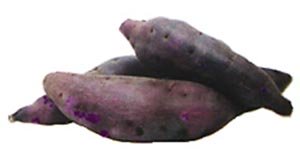Sweet potato Nutrition facts
Sweet potato is not only sweetens your taste buds but also good for your cardiovascular health! This underground tuber was initially cultivated in the Central American region.
Botanically, this starchy tuber plant is a dicotyledon, belonging to the family of Convolvulaceae, and named botanically as Ipomoea batatas. Its crunchy, sweet flesh is an abundant source of flavonoid pigment antioxidants, vitamins, minerals, and dietary fiber that are essential for optimal health.

|
| Sweet potatoes. |
Sweet potato is grown throughout the tropical and warm temperate regions. The crop just requires sufficient water and little attention for its successful cultivation.
The tuberous root features an oblong/elongated shape with tapering ends and has smooth outer skin whose color may range from red, purple, brown, and white, depending upon the cultivar type.
Sweet potatoes should not be confused with yams, another starchy root widely grown in Western Africa. Yams are indeed larger in size can weigh up to 120 pounds in weight and are 2 meters in length. Yams are tropical crops and indeed never grow where the temperature dips below 68 degrees F. Important differentiating features that distinguish sweet potatoes from yams are:
Sweet potatoes (Ipomoea batatas) are dicotyledonous, relatively smaller, and possess very thin peel.
Whereas, yams are monocotyledons, larger, feature thick, rough, dark brown to pink skin depending upon the cultivar type.
Internally, sweet potato has starchy, sweet flesh and, depending upon the pigment concentration, their color ranges from white through yellow, orange, and purple.
Boniatos, also known as Cuban sweet potatoes, feature dry, starchy flesh underneath the reddish-brown skin. They have a mildly sweet flavor and are cooked in a similar fashion to potatoes.
Sweet potato greens are also edible. In fact, the tender shoots and leaves contain more nutrients and dietary fiber than some of the popular green leafy vegetables like spinach.

